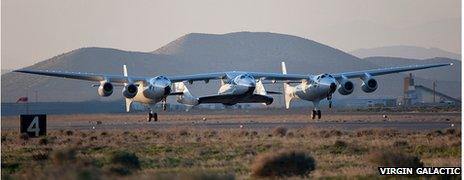Virgin spaceship aims to be science lab
- Published

For research flights, the passenger seats would be removed and replaced by experiment racks
Sir Richard Branson wants his tourist spaceship also to become a high-altitude science platform.
The billionaire's rocket plane will carry six fare-paying passengers just above the atmosphere to experience a few minutes of weightlessness.
But the vehicle has been designed so that its seats can be removed easily and the space filled with science gear.
Passenger flights should begin in 18 months or so; research sorties could start soon after.
The US space agency (Nasa) has already chartered the rocket plane.
"It's likely we might do some science flights quite early in the programme," explained Will Pomerantz from Virgin Galactic, external.
"Nasa is certainly eager to get their flights conducted - the ones they have already purchased.
"It may also give us some additional time to show off the reliability and the operations of the vehicle, which would give our tourism customers even more confidence.
Virgin executive Will Pomerantz told the BBC's Jonathan Amos what exactly the company had planned
"I think that if they see a Nasa flight has gone up and gone well, that will make them feel better about their purchase," he told BBC News.
Mr Pomerantz was speaking here at the American Geophysical Union (AGU) Fall Meeting, external, the largest annual gathering of Earth scientists.
His intention was to inform this community of the capabilities of SpaceShipTwo (SS2), as the vehicle is sometimes called.
The Virgin executive said geoscientists might want to use SS2 to pursue a range of research fields, including atmospheric chemistry, climate studies, space weather, or even to carry out simple Earth imagery.
The ship will have 43cm-diameter (17in) windows with high quality glass through which to point camera lenses.
It is likely some groups will want to fly their experimental sensors on the plane before committing the technology to an orbiting satellite, Mr Pomerantz added.
SpaceShipTwo is an air-launched vehicle. It will be taken aloft to about 50,000ft (15,200m) by its carrier aircraft WhiteKnightTwo.

On release, SS2 will then ignite a rocket engine to climb to a maximum altitude of about 361,000ft (110km).
Passengers will ride the rocket plane for the fun of it, but scientists would use it for the same reasons they also fly experiments on the International Space Station (ISS) or on sounding rockets - to access microgravity conditions.
The weightless environment provides a unique perspective on physical systems and processes, and is helping researchers to better understand disease and to develop new materials.
"We'll get something on the order of four to five minutes of weightlessness," explained Mr Pomerantz.
"It depends exactly what quality of microgravity you require for your experiment, but it's somewhere in that range.
"Generally speaking, we're similar to or perhaps slightly less than a sounding rocket, depending which sounding rocket it is, but we offer a much larger volume and mass capability.
"The other difference is that sounding rockets take quite a lot of g's; those things really jump off the rails and often will pull 10 g's on lift-off. Because SpaceShipTwo was designed for tourists, it's got a much gentler ride. That could be very important to some scientists."
Virgin Galactic recently signed a deal with the Houston company Nanoracks, external to design and build SS2's payload mounting system.
The intention is that is uses the same standards as those already specified for the ISS.
The costs of chartering the entire volume of SS2 for science would be broadly comparable to price charged to a full cabin of tourists, Mr Pomerantz said. Tourists are being asked pay $200,000 (£124,000) per seat.
Jonathan.Amos-INTERNET@bbc.co.uk and follow me on Twitter: @BBCAmos, external
- Published11 July 2012
- Published18 October 2011
- Published11 October 2010